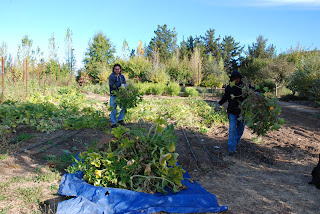We talk frequently about transition and ongoing changes at the farm—not to be repetitive
but because these changes are in fact, the constant at the farm.
Every day there is growth, some things wither and die while new things blossom.
A simple but significant metaphor for our lives, the work at the farm
keeps us focused on the flow of nature.
 |
| raspberry bushes going dormant after bountiful summer |
 |
| a few golden raspberries still wanting to party |
Did you know that 90% of all raspberries sold in the United States
come from Washington, Oregon and California. We are lucky to grow our own at the farm. And more raspberry trivia: Raspberries can be either
red, purple, gold or black in color.
The golden ones are sweeter than the other varieties. Lucky us!
Once raspberries are picked, they won't ripen any further, so even as we
are past harvesting these gems for this season,
we'll let the last few hardy ones do their thing!
 |
| Persimmons in the Orchard not quite ready, but soon! |
Following the rhythm of the farm, we pay attention to these cycles.
While these transitions occur on their own, there are other changes that require
our assistance. Knowing the summer squash
was past its prime and needing to replenish the beds for winter planting,
our assistance. Knowing the summer squash
was past its prime and needing to replenish the beds for winter planting,
we recently set to work on the lower quad.
Actually whether you plant a winter garden or not,
fall should not really be viewed as the end of summer gardening season,
but rather the beginning of a new garden for next spring.
to the soil now—goes a long way to improving next year's harvest,
even reducing the amount of work next spring to prep the farm.
While any seasonal change encourages you to stop and take stock,
it seems like this time of year particularly inspires some reflection.
As days get shorter and we hurry to harvest summer's bounty, preparing for winter,
we appreciate what the farm has given us and make a commitment to give back.
A wonderful book celebrating "the cyclical rhythms of nature" that came out in 2009
(but is still relevant) is The Seasons on Henry's Farm.
Worth the read to understand how "sustainable agriculture which mimics nature,
and the life of an extended family that not only
believes in
the importance of stewarding the land but lives it every
day.
The author invites us to recognize our place in the cosmos,
and to
understand that growing good food does not mean
destroying soil and
water, and that we can eat well and live well,
and still leave this
earth a better place than we found it."
We try to do our part.
The farm project is an important aspect of our business and our philosophy.
As is sharing the fruits of our labors with you, at our tables and in this blog.
Let us know how you celebrate the change of seasons.
And follow us here to experience the next cycle for us at the girl & the fig farm project.

















